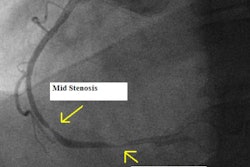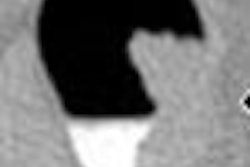A common anecdote entered the realm of clinical statistics when Israeli radiologists decided to refine the diagnostic results of treadmill stress testing with 64-slice CT coronary angiography (CTA).
Stories abound of people falling ill after passing a cardiac stress test with flying colors -- former U.S. President Bill Clinton comes to mind -- but who knew how often CTA might shed more light on the extent of coronary artery disease?
In an effort to clarify the relationship between the two exams, researchers from the Lady Davis Carmel Medical Center in Haifa, Israel, sought to assess the additive value of MDCT by comparing 64-slice CT angiography to treadmill testing for detecting coronary artery disease. CTA adds significant information to the diagnosis, the team reported at the 2005 RSNA meeting in Chicago.
"Stress testing is commonly used for noninvasive diagnosis of coronary artery disease, but it has limited diagnostic accuracy," said principal investigator Dr. Tamar Gaspar in her presentation. "We assessed the additive value of 64-slice CT in the clinical decision-making of patients undergoing treadmill stress testing."
Gaspar, along with Drs. Ronen Rubinshtein, David Halon, Jorge Schliamser, and colleagues, examined 182 consecutive patients who were referred for stress testing. Of these, 116 were elective procedures for suspected chronic stable angina, and 66 were in-patients referred for suspected acute coronary syndrome. Sixty-nine patients, or 38%, had prior coronary revascularization, Gaspar said.
The stress test was deemed positive based on an ECG change of greater than 1 mm resting ST depression. It was equivocal when baseline ECG was abnormal, or there was insufficient stress with less than 85% of target high heart rate. Patients with negative stress tests had less than 1 mm ST segment depression.
The presumptive diagnosis and decision to proceed with invasive coronary angiography catheterization were documented by two senior cardiologists and a senior radiologist before and after MDCT results. The group defined significant CAD on MDCT as a greater than 50% narrowing of the lumen. Arterial segments proximal to functional bypass grafts were excluded. In patients with prior coronary imaging, MDCT was also assessed for CAD progression.
All patients were imaged on a Brilliance 64 MDCT scanner (Philips Medical Systems, Andover, MA) and also underwent cardiac stress testing.
According to the results, stress tests were negative in 76 patients, but MDCT showed significant coronary artery disease in a quarter of these patients (19/76, 25%), of which 18 of the 19 were confirmed by invasive coronary angiography. Stress test results were equivocal in 57 patients, but MDCT excluded CAD in more than 50% of these patients, Gaspar said. Finally, MDCT showed significant coronary artery disease in 25 patients, which was confirmed in 22 of the 25 cases on coronary angiography.
Stress testing was positive in 49 patients, and MDCT showed significant luminal narrowing in 16, or 33% of this group, Gaspar said. Fifteen of these 16 cases were confirmed by catheterization, which found insignificant narrowing in 33. Five of these patients had invasive coronary angiography, which confirmed the diagnosis.
Among the patients that had both MDCT and intervention, five had false-positive MDCT, and one had a false-negative MDCT. But all six of these patients had borderline stenosis of 40% to 60% on MDCT. "When we had to decide if it was above or below 50%, we decided below," she said.
Twenty-eight patients with positive stress test results were treated medically without intervention. Of these, 12 had a false-positive stress test with normal results on MDCT, 11 had distal disease or local progression on MDCT compared to previous angiograms, five had patent stents, one had a proximal stenosis, and one a vascular tumor, Gaspar said.
"A six-month follow-up of all patients discharged without intervention showed no deaths and no infarcts," she said. Two patients from this group underwent intervention within three months.
The researchers found that "MDCT diagnosed obstructive coronary artery disease in a quarter of patients with a negative stress test, and excluded significant coronary artery disease in over half of the patients with equivocal stress tests," Gaspar concluded. "MDCT allowed differentiation between new and old disease in patients with a positive stress test, thus avoiding unnecessary interventions. Overall, MDCT is a useful tool to refine the diagnosis in a wide range of patients undergoing coronary stress testing."
By Eric Barnes
AuntMinnie.com staff writer
February 7, 2006
Related Reading
More cardiac services don't reflect more heart disease, January 25, 2006
Playing their hearts out: Do young athletes need cardiac screening? August 16, 2005
Early stress testing can be safe in selected cardiac patients, January 17, 2005
Scan centers take heart in 'Clinton syndrome,' September 16, 2004
Copyright © 2006 AuntMinnie.com



















